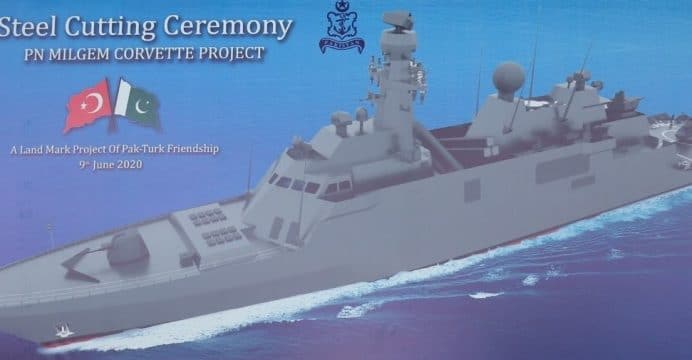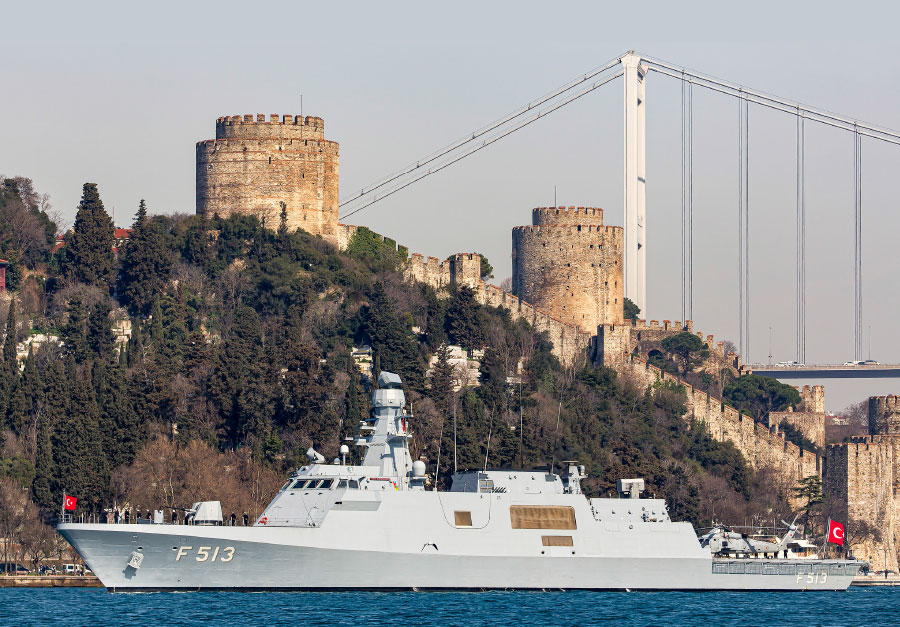In July 2018, Pakistan inked a contract with
Turkey’s Military Factory and Shipyard Corporation (i.e., ASFAT A.Ş.) for four MILGEM corvettes for the Pakistan Navy (PN).[1]
In addition to acquiring a heavily customized version of the MILGEM, Pakistan will also gain ownership of the design’s intellectual property (IP).[2] Earlier articles on Quwa outlined the likely capabilities of Pakistan’s MILGEM configuration – also known as the Jinnah-class corvette (or frigate) — and how owning the IP could lead to the construction of units beyond the initial four ships.
In fact, the latter should be the likeliest outcome considering that, by 2030, the first of the PN’s existing four F-22P frigates will by 20-years of age, which may necessitate a successor ship by 2040-2045. However, there is more potential in the MILGEM design than simply a 1:1 means of replacing old ships. Should the PN continually invest in the MILGEM, it may gain a cost-effective qualitative and quantitative driver.
The Pakistan Navy’s Challenges
Structural economic woes and, in turn, recurring fiscal constraints have prevented the PN from effectively pursuing a qualitative edge over the Indian Navy (IN). In fact, the PN has arguably lost its qualitative edge against the IN as well, especially as the latter adds high-tech surface warships, helicopters, and other key technologies to its arsenal. Fortunately, the PN has built a relatively impressive procurement pipeline too – by 2030 it will have 12 modern large (i.e., 2,400+ ton) surface warships (i.e., Type 054A/P, MILGEM and F-22P), 11 submarines with air-independent propulsion (AIP) (i.e., Hangor and Agosta 90B), and a fleet of new long-range maritime patrol aircraft (LRMPA) to complement its aging P-3C Orion LRMPAs.
However, the PN’s varied acquisition plans will induce logistical challenges, at least in the near-term. The F-22P, Type 054A/P, MILGEM, and FFG-7/Oliver Hazard Perry (OHP) each draw on propulsion, electronics, and weapons from different sources. This is costly from a maintenance overhead standpoint as it involves multiple supply chains (some from potentially tenuous Western sources). However, it also presents some training and operational/deployment challenges, especially as each ship-type generally operates its own distinct suite of combat management systems (CMS) and weapons, among other subsystems.
Thus, while the PN’s acquisition pipeline will result in key capability gains – especially in terms of anti-air warfare (AAW) – they will not solve existing logistics issues. However, after 2030, the PN can – and should – leverage the MILGEM to consolidate most of its fleet on one design. Yes, one can expect more MILGEM ships, the PN should enlarge the program’s scope by pooling all future ships under this design.
Option 1: Design an ‘AAW MILGEM’
One route the PN can take is to design a MILGEM/Jinnah-class configuration that delivers ‘high-end’ war-fighting capabilities, such as long-range AAW. Qatar’s forthcoming Doha-class corvettes – i.e., which use a design similar in dimensions to the Jinnah-class – will deploy MBDA Aster-30 long-range surface-to-air missiles (SAM). Thus, fitting the MILGEM with long-range SAMs of similar size should be possible. Granted, the main limitation in this scenario would be the lower number of vertical launch system (VLS) cells (i.e., 16 cells in the MILGEM versus the Type 054A/P’s 32 cells).
However, considering that the Jinnah-class is a lengthened version of the Ada corvette, the PN can opt to further lengthen the design. Indeed, the Turkish company Savunma Teknolojileri Mühendislik (STM) had showcased a 3,500-ton variant of the MILGEM in 2017 (i.e.,
CF3500). Thus, the PN can enlarge the MILGEM further and, in turn, spawn a new sub-class under the MILGEM family.
Option 2: Design Simplified, Low-Cost MILGEMs
Instead of importing offshore patrol vessels (OPV) or other sub-2,000-ton ships, the PN could also look at designing a low-cost variant of the MILGEM. Basically, the PN can strip the design to the hull and select a specific set of subsystems. In other words, the PN can ‘dumb it down’ to only mission-critical systems.
For example, an anti-submarine warfare (ASW) oriented MILGEM would carry a form of towed sonar array – rather than the hull-monted TBT-01 sonar. Towed sonar systems enable you to search at varying depths (assuming your cable is of sufficient length), letting the PN to look for sub-surface threats in deeper waters compared to hull-mounted systems. However, by omitting the VLS and ESM, Pakistan can produce these simplified single-mission corvettes at markedly lower cost than a full-fledged Jinnah-class.
Next Steps: Get a Hand on Inputs
Fundamentally, the challenge for the PN is not as much in acquiring a ship design and creating variants of it for different needs. The Jinnah-class is clear proof that (1) such expertise is available on the market and (2) certain foreign OEMs (at least the Turks) are open to helping Pakistan. Rather, the challenge ahead is finding affordable sources for on-board weapons (e.g., SAM), electronics, the steel, and other inputs. Even if the PN can ‘own’ a ship design, foreign governments may condition the transfer of their inputs with the purchase of their competing ship designs. This will be extremely challenging as Pakistan is not an industrial power, nor a fully developed research and development (R&D) powerhouse.
Fortunately, there may be an opportunity to collaborate across most critical inputs with Turkey. The Turks are actively investing in a wide range of programs including, among others, medium and long-range SAMs, anti-ship missiles, ship-based radars, ESM, composite superstructures, CMS, and many other inputs. Flag-ship products include the ÇAFRAD radar for the TF-2000 AAW frigate, the Hisar-U/SIPER long-range SAM, Hisar-O medium-range SAM, Atmaca anti-ship missile (AShM), and ORKA lightweight torpedoes.
Comprehensive review of the Pakistan Navy's MILGEM program, which involves four Babur-class corvettes and the design work for the Jinnah-class frigate.

quwa.org













